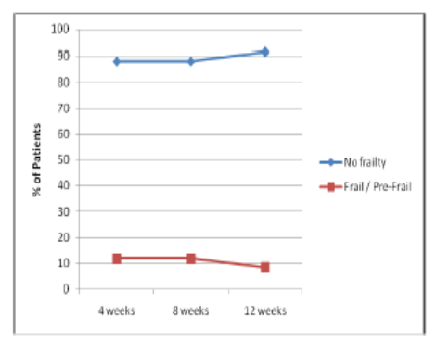


Indian Journal of Science and Technology
Year: 2024, Volume: 17, Issue: 1, Pages: 16-25
Original Article
Nalina Gupta1,2*, Palani Kumar3, Divya Patel4, Drishti Somani4, Nishtha Parmar4
1Professor, Department of Physiotherapy, Chitkara School of Health Sciences, Chitkara University, Punjab, India
2Former Professor, College of Physiotherapy, Sumandeep Vidyapeeth- An Institution Deemed-to-be-University, Vadodara, Gujarat, India
3Dean, College of Physiotherapy, Sumandeep Vidyapeeth-An Institution Deemed to be University, Vadodara, Gujarat, India
4Physiotherapist (ICMR), College of Physiotherapy, Sumandeep Vidyapeeth-An Institution Deemed to be University, Vadodara, Gujarat, India
*Corresponding Author
Email: [email protected]
Received Date:16 August 2023, Accepted Date:07 November 2023, Published Date:05 January 2024
Objectives: To find out the effect of multicomponent exercise programme on sarcopenia and frailty in elderly population. Methods: This was an observational study. The elderly population with an age group of >60 years residing in villages within 10–15 km of Sumandeep Vidyapeeth, Vadodara, India, was considered in the study. The study population consisted of 205 participants who were diagnosed with sarcopenia and frailty during phase 1 of the study. The study was conducted from August 2022 to May 2023. The participants were placed on a multicomponent exercise programme that included resistance training exercises, balance exercises, flexibility exercises, and endurance exercises. Grip strength, muscle mass, appendicular skeletal muscle mass (ASM), skeletal muscle index (SMI), calf circumference (CC), gait speed, and frailty were assessed at the end of 4 weeks, 8 weeks, and 12 weeks. Microsoft Excel and STATA-IC statistical software, version 13, were used to analyse the data. Findings: A total of 59 participants adhered to exercises for 12 weeks. Mauchly’s sphericity test showed a statistically significant change in ASM and SMI (P = 0.001). In the subject effects over a duration of 4 to 12 weeks, there was no statistically significant difference found in grip strength (p = 0.257), right CC (p = 0.114), ASM (p = 0.109), SMI (p = 0.052), and gait speed (p = 0.641). At the end of 12 weeks, there was a reduction in the status of frailty 1.7% "frail," 6% "pre-frail,” and 91.5% “no frail” as compared to 3.4%, 8.5%, and 88.1%, respectively at 4 weeks. Conclusion: In the present study, multicomponent exercise programme had no statistically significant effect on sarcopenia (grip strength, muscle mass, or gait speed) according to the follow-up data from weeks 4 to 12. Despite this, a 12-week exercise programme improved the frailty status. Novelty: This study is one of its kind where elderly population having Sarcopenia and Frailty were given exercise programme for 12-weeks of duration at their doorsteps in the community.
Keywords: Sarcopenia, Frailty, Exercise, Older adults, Multicomponent Exercise
© 2024 Gupta et al. This is an open-access article distributed under the terms of the Creative Commons Attribution License, which permits unrestricted use, distribution, and reproduction in any medium, provided the original author and source are credited. Published By Indian Society for Education and Environment (iSee)
Subscribe now for latest articles and news.